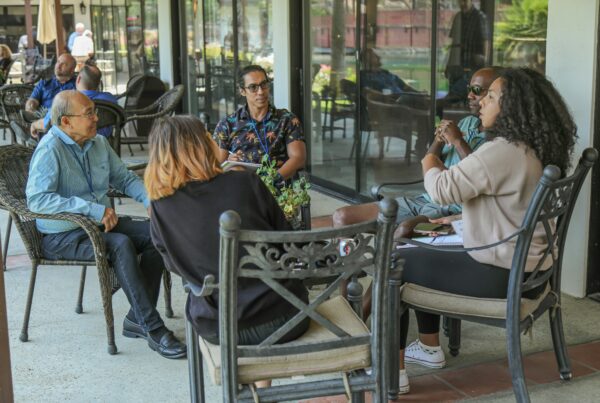W hile Christmas is always a great opportunity for your church to intentionally connect with your community, it is especially relevant in an unprecedented year where the messages of hope, peace, and reconciliation are not to be taken for granted and are likely buried beneath loss, loneliness, grief, and deep need. Each Christmas, it is common to see an increase in people with no religious affiliation or limited attendance visit a church for a Christmas service. As with Easter, more people are drawn in or willing to enter a church because of messages of hope and joy, holiday specialness, or a sense of familial connection or tradition. These pulls feel deeper this year, as each community undoubtedly has people longing for connection, struggling because of lost jobs, and grieving the loss of loved ones and normality. We are all yearning for a message of hope.
This Christmas season, even with continued shutdowns and physical distancing, you can still be intentional about celebrating the birth of Christ not only with your friends and family but also with members of your community. Here are some ideas for connecting with your community, providing opportunities to share the hope of Christ, the newborn King.
1. Be a champion of local charities and non-profit organizations supporting underserved populations.
The numbers of people experiencing homelessness and domestic abuse have been soaring during the COVID-19 pandemic. Many organizations and small businesses raise awareness and support for such people and others on the margins. Promote the organizations’ fundraisers on your social media platforms. Encourage your congregation to support the efforts of these organizations. Show what your church is doing to support your community through local programs. Shop local. Promote local businesses on social media and raise awareness within your congregation.
2. Update your digital presence.
Americans search for “church” more around Christmas and Easter than any other time, so make sure your webpage is easy to navigate, welcoming, and up-to-date with any changes due to COVID-19. Then, take a second look at the basics, too. Make sure your links are correct, your church address and service times are listed, and all the primary information about your church is easy to find so visitors know what to expect.
3. Make a batch of cookies for your neighbors.
If you are looking to invite a neighbor to an in-person or online service, but aren’t sure how to start the conversation, try using baked goods as an approach. Cookies are a great excuse to connect with your neighbors and a way to show you care, if you can safely do so. Remember, sometimes all someone needs to attend church is an invitation. Looking for a cookie recipe? Try this fantastic cookie recipe!

Bonus: Make it fun! Why deliver cookies in any shirt, when you can sport an ugly Christmas sweater or partake in a Christmas spirit competition? Take pictures of you, your family, or roommates in your holiday wear as you make your deliveries.
Related idea: Host a festive dress virtual competition with folks in your small group. Post the photos on social media, and let your friends decide the winner.
4. Have a food bank drive.
Consult with your local food bank about how best to serve them, whether with monetary donations or non-perishable food donations, or both. Rally your congregation to help. Set a goal and see what you can achieve!
Many food pantries do extra food giveaways this time of year and may need extra help. Also, in the winter months, their consistent volunteers—often retirees—may head down south or be otherwise unavailable, so food pantries may need extra volunteers.
5. Remember simple ways to be friendly and kind.
Even saying hello in the grocery store or giving simple well wishes can make a big difference as people are missing and craving human connection in this season. Remember to thank your cashier or bank teller. Ask how their day is going, if you think it will be well received, and genuinely listen to the answer. Being brave and offering a friendly wave feels like a big deal these days, as we’ve weathered a tough year together.

6. Invite your “family” in on the fun.
Whether it’s your roommates, kids, or small group, if possible, do it together! Sit down and write cards together for people who are shut-in, whether they’re at local residential centers or people in your church who are likely feeling extra isolated this year. Deliver cookies together, and have kids design and make the tags. Ask your church for a list of people who might be blessed by a Christmas card this year.
7. Socially distant caroling.
Without in-person worship during the COVID-19 pandemic, many people are missing out on singing the wonderful Christmas songs. In small, socially distanced, masked groups, you could bless neighbors by caroling. You may need to carol from front yards or driveways rather than front porches, but sharing the gift of music and singing carols together may be a wonderful way to bless your community.
8. Explore your community through a scavenger hunt.
Many households put decorations and lights in their yards for the holidays. Folks from the congregation and community can search the neighborhood for certain items like a funny Christmas inflatable or something unique to a particular heritage. A digital map can be created or simply a list of homes in the community that are especially fun to see.
Bonus: this could even be a photo scavenger hunt where individuals or small groups submit their findings. Whoever finds the most unique decoration could win a prize—a gift certificate to a local small business, for example.


Eliza Cortés Bast
Eliza Cortés Bast previously worked as coordinator for Local Missional Engagement and special projects for the Reformed Church in America.

Laura Osborne
Laura Osborne is the RCA coordinator for interreligious relations and a campus minister with the International Student Fellowship at Western Michigan University in Kalamazoo, Michigan. You can connect with Laura by email at losborne@rca.org.
Eduardo Rodriguez previously served the Reformed Church in America in the areas of local mission engagement and leadership.



